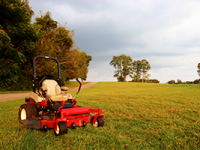New Compact Design Solves for Typical Check Valve Challenges
 Check valves are commonly applied to a variety of load holding applications that are found, for example, in mobile equipment in mining, construction, or forestry. Typical thread in cartridge style check valves are large and mount to the surface of a manifold block. This surface mounting adds to the complexity and cost because of the additional machining or drilling of internal passages required to integrate the valve into the circuit. The compact design of Parker’s new thread-in cartridge valve is an ideal solution because it allows for an internal mount.
Check valves are commonly applied to a variety of load holding applications that are found, for example, in mobile equipment in mining, construction, or forestry. Typical thread in cartridge style check valves are large and mount to the surface of a manifold block. This surface mounting adds to the complexity and cost because of the additional machining or drilling of internal passages required to integrate the valve into the circuit. The compact design of Parker’s new thread-in cartridge valve is an ideal solution because it allows for an internal mount.
The CVH021 can be compact in nature because of its application; used in circuits to isolate pressure signals to flow compensators and load sense lines for pumps. Load sensing is a common methodology used for pump control on many multifunctioning hydraulic circuits that use a variable displacement pump. In load sensing circuits with two or more functions, it is important to use check valves to isolate the signal from each function. This ensures that the pump control is receiving the highest pressure signal in the circuit while multiple functions are being used at the same time. (The pump control receiving the highest pressure means the pump output is increased to meet the demand of the highest demand function).

The operation of typical check valves
When used as a pressure sensing isolation check valve, the need for zero leakage and flow rates over 4 LPM (1 GPM) are not required. Standard check valves are available in a C8-2 or C10-2 cavity configuration but these are large and costly, given the number of check valves needed. The cavity can also restrict the placement within a manifold. The schematic above shows an example circuit where isolation checks are used.
 As with cast iron sectional valves, a common practice to reduce cost and save space was to drill the check valve seat into the manifold then drop in a ball, spring and port plug. While simple in design and function, these types of check valves are not durable, as neither aluminum or cast iron manifold material hold up to the cycling with flow and pressure impacting the ball onto the seat. Further complications arise for service since it can be difficult to change out in the field with loose springs and balls. If the seat is damaged, there is no service possible and the entire manifold would then need to be replaced.
As with cast iron sectional valves, a common practice to reduce cost and save space was to drill the check valve seat into the manifold then drop in a ball, spring and port plug. While simple in design and function, these types of check valves are not durable, as neither aluminum or cast iron manifold material hold up to the cycling with flow and pressure impacting the ball onto the seat. Further complications arise for service since it can be difficult to change out in the field with loose springs and balls. If the seat is damaged, there is no service possible and the entire manifold would then need to be replaced.
Using the CVHO21 as an isolation check valve
When used as an isolation check valve, the CVH021 provides a good solution. It incorporates the seat and ball in a single cartridge that fits an SAE 2-style port that can be machined in the manifold to be part of the port connections between valves, without the need to be a surface mounted cavity valve. The heat treated seat and ball bearing provide a durable, high cycle design that allows for simple service if needed.
Parker Isolation Check Valves are available from the Hydraulic Cartridge Systems Division. Consult your HCS catalog or www.parker.com/hcs for more information. You can also contact a Product Manager or Technical Support Specialist for help at 847-955-5000 or HCSTechnical@parker.com.
 Article contributed by Bill Guse, senior principal engineer, Hydraulic Cartridge Systems Division, Parker Hannifin Corporation.
Article contributed by Bill Guse, senior principal engineer, Hydraulic Cartridge Systems Division, Parker Hannifin Corporation.
Related Content:
Three Ways to Improve the Operation of Your Proportional Valve
Load Sensing Valve Improves Heavy Duty Machine Productivity and Fuel Savings
Electronic Control Systems for Heavy-Duty Vehicle Implements
Source: Parker Feed





